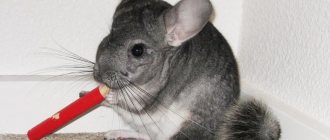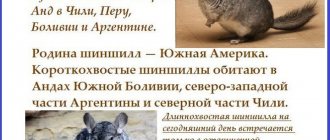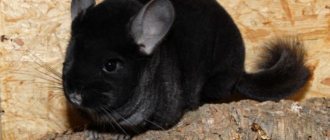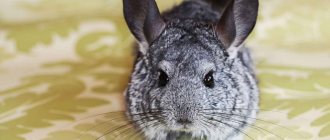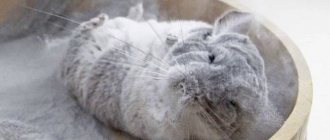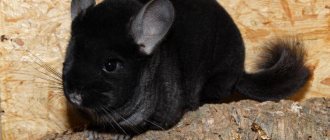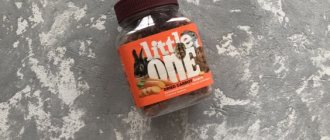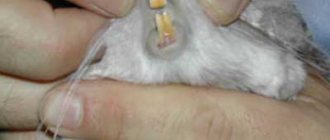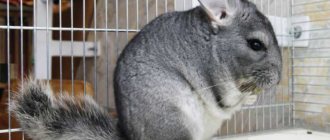Diseases: how dangerous they are and how to treat them
These animals have strong immunity, which is why, with proper care, they rarely get sick. But being in unfavorable conditions can negatively affect their well-being. If the animal experiences a loss of appetite and decreased activity, this is a cause for concern. The following diseases are typical for chinchillas:
- Bronchopneumonia is accompanied by fever, difficulty breathing, nasal discharge, cough and wheezing. The animal is treated with glucose and vitamins. And also small doses of penicillin. This drug is prescribed intramuscularly once every three days. The dosage must be agreed with your veterinarian.
- Rectal prolapse. This causes constipation. The fallen part is first treated with furatsilin solution, then with paraffin oil and, using a pipette, carefully set.
- Formation of hair rings around the male genitals. This prevents it from reproducing. The rings are removed by hand. If they are dry, they are treated with a soap solution.
- Constipation. It can be caused by a lack of fluid and changes in diet. If there is such a problem, dry food is excluded. The pet is given a laxative and paraffin-based oil is injected into the mouth or rectum.
- Keratitis is a lesion of the cornea of the eyes. The disease occurs due to contact of the chinchilla with poor-quality sand or mechanical damage. The eyes are washed with furatsilin and treated with levomecithin or tetracycline ointment.
- Dental diseases occur when there is no stone to grind down. The animal's incisors reach 8 cm and injure the tongue. The molars move. The chinchilla is unable to eat and dies. Treatment involves grinding down the teeth, but this procedure must be performed by a veterinarian.
- Conjunctivitis manifests itself as purulent or clear discharge from the eyes. May indicate the presence of an infection. The animal's eyes are instilled with fluorescent, then treated with eye ointment every hour.
- Ticks. They can be detected after careful observation of the animal. The chinchilla's skin peels off and becomes thicker, and the animal suffers from itching. The animal loses weight, and in the absence of adequate treatment, dies. The wool needs to be cut, and the affected areas should be treated with bromocyclene at intervals of 8 days. The dosage is prescribed by the veterinarian. You will also need to disinfect the cage.
- Flatulence occurs as a result of feeding poor quality food. The animal's temperature drops to 34.5°C, and its general condition worsens. The animal is given activated carbon in powder form. You can use dill water or chamomile infusion. It is better to coordinate treatment with your veterinarian.
- Otitis is an inflammatory process that affects the external auditory canal. It is the result of pollution. The disease can be detected by the leaking brown liquid. The ear is treated with fish oil and ointment containing zinc.
- Diarrhea – occurs due to stress and unbalanced nutrition. The animal's temperature rises. He is given oak bark, maple leaves and activated carbon.
- Heatstroke. This ailment can be recognized by observing the behavior and appearance of the animal. It lies on its side, the ears turn red, and copious amounts of saliva appear. The chinchilla is moved to a cool place and a cold object is placed in the cage. For example, a bottle filled with cold water.
- Ringworm – baldness appears on the back, sides, head, neck and tail. The skin peels and becomes inflamed. The animal is treated with a 5% iodine solution, medical sulfur or fungistop.
Color
Experts note 3 main types of chinchilla color:
- golden;
- silver;
- silver shaded.
Less common are marbled, tortoiseshell, fawn, tabby, harlequin, bicolor, and cinnamon cats.
The golden chinchilla cat is less common than its silver relatives. This species has a reddish color on the back, sides and tail. The neck and belly are creamy.
Silver pets are white and 1/3 black. Silver shaded – white with fur darkened by 1/8.
How to tame a young animal?
The small chinchilla is quite timid, so taming should be gradual and careful so that the animal is not stressed. How to tame a chinchilla at a young age?
It is important to speak kindly to the rodent and often flash before its eyes so that the chinchilla gets used to its owner. But when communicating, you should keep your distance - do not put your face too close to the rodent and do not touch it with your hands. You need to approach your pet at a quiet and slow pace; sudden movements and noise can frighten the chinchilla. At first the animal will behave fearfully
But when he stops hiding, you can try to open the cage door, the movements should be smooth and careful. No taming is complete without treats. Therefore, after 3-4 days, you can give the little chinchilla some tasty treat by opening your palm. After 7 (sometimes 14) days, the chinchilla will take treats from your hands. And only after that you can try to pet her and pick her up. Some owners make a certain sound (for example, clicking) before approaching the cage. After some time, the chinchilla associates this sound with the owner approaching it, which means there will be games or treats ahead.
Mobility
Aristocratic chinchillas would rather lie imposingly than rush around the house. Although they are not averse to frolic, but in moderation. There are no special transition stairs for them, no ropes are laid out so that they have somewhere to spend excess energy. These are pets that decorate the house.
In Western countries, an owner is considered bad if a domestic cat has less than 2 toys. There is no need to count the number of cute objects our cats have, but the animal will feel better if it has its own toys. Stores offer active and educational games for cats. The British are considered to have intelligence. Devices that develop logic have been developed for them. Toys will have to be updated periodically.
Cage interior
Inside, the animal’s cage is filled with important elements necessary for the healthy functioning of chinchillas.
Retreat house
Be sure to install a house inside the cage. You can buy it at a pet store or make it yourself using wood as a wall material. Such a refuge inside the cage is necessary so that the animal can retire, hiding from the views of others.
DIY chinchilla house
Tray
Chinchillas use ordinary cat litter boxes as toilets. To save space inside the cage, purchase a corner option. Of course, your pet won't know how to use the litter box correctly at first, but over time you can get him used to it. You just need to be patient.
Chinchillas very quickly get used to visiting the litter box.
How to train a chinchilla to use a litter box
Sand bathing suit
A mandatory procedure for keeping a chinchilla's fur in order is bathing in seliolite sand. Using this exotic procedure, the animals remove accumulated dirt from their fur. In the wild, chinchillas used volcanic dust, which can easily be replaced by sand at home.
What does a purchased chinchilla swimsuit look like?
You can make a swimsuit yourself. Suitable for this:
- large plastic container;
- a water bottle with a hole cut in the side;
- plastic canister;
- small basin.
Take care to secure the product tightly to the wall of the cage, as intensive bathing in the sand by animals can lead to the bathtub turning over.
You can make your own bathing suit for chinchillas
The sand inside such a bathing suit can be either anti-inflammatory or regular. In the first case, you will have to change it for a new one approximately once every two months, in the second - once every two weeks. If this is not done, microorganisms will develop inside the sand, which will then settle in the chinchilla’s coat and cause dermatitis and other skin lesions.
Drinking bowl
A drinking bowl for chinchillas is purchased at a pet store, not just any kind, but a special one for rodents. The device is hung at a height of 10 centimeters from the base of the cage. Only boiled, clean water is poured inside.
Drinking bowl for rodents
Feeder
This device is available in two options:
- floor;
- hinged.
If you prefer the first option, choose a heavy product, since the animal often turns over light containers, spilling water on the bedding.
Ceramic feeder for chinchillas
Mounted feeder
How to line the bottom of the cage
The floor of the cage should be covered with thick carpet. Walking on such flooring, the chinchilla will protect its paws from damage on the slatted floors of the cage.
Coniferous sawdust can serve as bedding.
Unable to use this material, opt for soft sawdust or commercial pine litter for cat litter boxes. It will not only draw out various odors, but also disinfect chinchillas’ paws, protecting them from various diseases.
Where is it better to have a chinchilla in an apartment or in a house?
Home environment is an important factor to consider before adopting a chinchilla. There is no fundamental difference between a private house and an apartment. Such a pet does not need to be walked, so if you can allocate enough space for a cage or display case, everything will work out well.
boy - Shusha It is much more important to choose the right room. Remember that the chinchilla is a nocturnal animal: during the day it sleeps most of the time, but at dusk it begins to become active. Putting a cage in the bedroom would be a bad idea - the rodent will simply not let you sleep. And in the kitchen or living room the pet itself will be uncomfortable due to the noise of equipment and conversations.
Chinchillas are very sensitive to temperature changes. For example, overheating (above 22°C) can cause heat stroke and death
Therefore, it is important to monitor the indicators both in summer (have air conditioning) and in winter (control the heating system)
This point should be taken into account by residents of apartments in high-rise buildings, because in many buildings the housing and communal services are responsible for this, and it can be problematic to equalize the indicators with personal equipment. In order not to endanger your pet, take care of a suitable environment and only then get a chinchilla.
How to choose a chinchilla: a pet with character
So, if you decide to get this cute creature, then when visiting a chinchilla breeder, pay attention to the behavior of the animals when the owner approaches the cages or opens the doors. Keep in mind that each animal has its own unique character.
Some of the chinchillas run up to the open door with curiosity and even try to take advantage of the opportunity to get out. These are definitely leaders. They are not only the most active, but also the most restless, and at the same time, the most interesting animals. Communication with them will bring a lot of pleasure and positivity, especially to children.
There is also a type of animal that, when the cage is open, is not in a hurry to leave it, but first tries to find out for what purpose it was opened: whether they want to feed them, offer them a walk, or want to transplant them into another cage. This category of chinchillas has a calm character and balanced temperament. It is good to form long-term pairs from such animals, when the female and the male constantly live together and take care of the offspring.
But there are also chinchillas who either show virtually no reaction when the door is opened, or even try to hide in the farthest corner of the cage. Similar behavior is observed when kept in groups, and these animals are in a depressed state. If you do choose such an animal, then, to be honest, its character is difficult to predict. If the animal is already an adult, it may become withdrawn and avoid contact with humans. If he is still a baby, then perhaps he will grow up to be a cheerful and sociable pet. But if your animal still turns out to be too closed, then in the end, establishing friendly contact with it will depend only on your patience and the time you devote to it.
So, we have decided on the character of the animal. But besides this, we need, of course, a healthy animal.
Chinchilla and hamster in the same cage
A chinchilla and a hamster will also not get along together in the same cage, because these animals differ not only in size, character and behavior. Furry pets have completely different body needs and feeding them with one food is not recommended.
Food for chinchillas contains mainly cereals, dried greens and seeds, and ready-made food for hamsters contains dried fruits and vegetables, which do not provide any benefit to animals from South America. Fresh vegetables and fruits, which are delicacies for hamsters, should also not be consumed by chinchillas.
The menu of hamsters can sometimes be diversified with dairy products, but giving chinchillas milk or cottage cheese is contraindicated, as this will lead to the development of gastrointestinal tract diseases or even food poisoning in pets.
We should not forget that, despite their miniature size, hamsters can be quite aggressive, especially Djungarian ones. A little pet can attack a furry neighbor and seriously injure her with his sharp teeth.
Chinchilla and hamster should not live together
Experts do not recommend keeping chinchillas together with degus, rats, hamsters and other rodents. If the owner wants to find a friend for a furry pet, then he should remember that these cute and timid animals feel most comfortable either alone or in the company of their fellow tribesmen.
They were abandoned, but now they are a family cats2friends
Let's get acquainted, we are a family cats2friends
: https://instagram.com/cats2friends and each of us has our own story, which we will tell about in the following posts.
goldfish comet - Gagarin.
Write about whom you would like to know more about.
Prohibited Products
Persimmons are prohibited for feeding. This fruit, useful for humans, is rich in iodine, which is contraindicated for animals. In addition to iodine, persimmons contain a lot of sugar and astringents, which will lead to constipation.
It is not recommended to give chinchillas and beets.
The root vegetable is healthy, but has a laxative effect. In rare cases, small pieces of beets can be given for constipation. Any type of cabbage leads to severe gas formation. Chinchillas love to feast on tea rose petals - they taste pleasant and have an attractive aroma. If flowers are grown in your own garden, there is no danger, but it is better not to give store-bought ones. They contain a lot of pesticides and chemicals that can cause serious poisoning.
When preparing tree branches for the winter, it is worth remembering which species are dangerous and unsuitable for feeding. Branches of which trees cannot be harvested:
- Apricot,
- white acacia,
- Beech,
- Ash leaf maple,
- Common buckthorn
- Cedar,
- Chestnut,
- Branches of any citrus species,
- Cypress,
- Elderberries,
- Cherries,
- Cherries,
- Branches of any coniferous species,
- Holly,
- Hydrangeas,
- Juniper,
- Common maple
- Myrta,
- Oleander,
- Plums.
Branches of stone fruit trees (cherry, cherry, plum, and so on) are dangerous because they contain a dangerous cyanide compound, as a result of the breakdown of which hydrocyanic acid is formed in the chinchilla’s body. If you feed an animal with such twigs, you can get not only severe poisoning, but also the rapid death of your pet.
Prohibited products also include any type of honey, as well as store-bought cottage cheese and fermented milk products.
Not all breeders know that chinchillas should not be given leaves, stems and flowers of indoor plants. Most of them are poisonous to the animal and very often cause death.
It is also not recommended to give any food from a person's table. Everything that is normal and familiar, even useful for people, for a chinchilla becomes the cause of digestive problems, allergies, obesity and other serious diseases. The animal will never refuse tasty and aromatic food and can eat a piece of cake, cheese, meat or fish. However, such food is not normal and familiar to the stomach of a furry pet. And the possible consequences are very sad.
History of breeding
For the appearance of British beauties, millions of fans of the breed thank English breeders, who in the 80s of the 19th century bred a completely new breed of cats.
The ancestors of the chinchilla are cats of the British smoky and Persian breeds. Although the first kittens appeared completely by accident, the breeders liked their unusual color so much that they systematically began to work on developing a new breed.
At first, the kittens had only silver fur, but later American breeders managed to achieve a golden color for chinchillas.
The appearance of the new breed was enthusiastically received by cat lovers. Due to the small number of the breed, British kittens were an expensive pleasure, which only rich, noble families could afford. The spread of chinchillas was facilitated by the Swedish Princess Victoria, who especially loved these plush cats.
Nutrition
Chinchillas are fed once a day in the evening, as they are nocturnal. The basis of the diet is balanced granulated food. Additionally, herbs are introduced - fresh and dried, apples, carrots. To maintain immunity and compensate for the lack of fresh air, it is necessary to give vitamin complexes weekly.
An adult animal eats about 50 g of food per day. However, it is necessary to take into account the rather large difference in the weight of animals depending on gender, species and age. Therefore, it is necessary to adjust the dosage for specific individuals.
Particular attention should be paid to the nutrition of pregnant females and young animals. For the first one and a half to two months, the cubs are fed with milk, then they are removed from the mother into a separate cage and given regular food.
It is extremely undesirable to change anything in the diet of females and young individuals, as they react sharply to new foods.
How to breed chinchillas of different sexes
Knowing the behavioral characteristics of females and males, you can avoid a conflict situation when placing furry pets of different sexes:
- if placement is carried out with the aim of producing offspring, then it is advisable to place the female in the cage with the male, since females more zealously defend their territory;
- a chinchilla pair is selected no earlier than the animal reaches six months of age;
- before placing a boy and a girl in the same cage, their homes are placed close together so that they can get to know each other and get used to the smell of others;
- if the acquaintance was successful and the rodents do not show aggression towards each other, they are swapped: the male is released into the female’s cage for several hours and vice versa;
- you cannot place a male with a girl when she is in heat, since boys are impatient at this moment, and the female needs time to get used to the suitor;
- To form a trio of adult chinchillas, follows this rule: one female, two males, since two girls will not tolerate each other in the same cage.
Is it possible to keep these two animals in the same room?
A properly adapted chinchilla and cat can get along even in tight spaces. Typically, cat owners look down on domestic rodents. But at the same time, they treat chinchillas condescendingly, preferring not to pay attention to them. The situation is good - there is peace and quiet in the house, no one is hunting anyone, no one is fighting with anyone.
However, there are often cases when rodents themselves provoked the cat into active actions. Rodents succeed in awakening a dangerous predator in their domestic pussy when the animal lacks a sense of proportion and its behavior crosses the boundary of what is acceptable. The most common reasons for starting hunting:
- Excessive curiosity - when a small animal tries too hard to get to know the cat better.
- Rudeness is when a rodent that has become accustomed to a new territory demonstrates disrespect for the other inhabitants of the house and tries to show itself as the boss.
Article on the topic: Is it worth getting a chinchilla: the pros and cons of a pet in an apartment
Regardless of what exactly provoked the hunt or just a conflict between the animals, the owner can only place the pets in different rooms and make sure that they do not intersect again.
Preparing to purchase a chinchilla
If you decide to have an exotic rodent at home, you should prepare your apartment for this event in advance. Before a chinchilla appears in the house you need to:
- Buy a chinchilla cage or make one yourself.
- Purchase the necessary equipment - a drinking bowl, a feeding trough, a hay barn, a house, a swimming pool, toys, a pallet.
- Purchase cleaning and disinfection products, mineral stone, filler, volcanic sand for bathing.
- Stock up on hay, food, and tree branches.
- Prepare a place for the animal to walk.
- Conduct an explanatory conversation with children.
- Look for a veterinary clinic closer to your home and make an agreement with the veterinarian in advance.
Focusing on sounds
Like cats, chinchillas are better at accepting names that contain whistling and hissing sounds (i.e. з, с, щ, з, ч, ж). By the way, it’s easier for the owner to pronounce such names.
Quite often, owners (especially young ones) name a chinchilla after a movie, book or cartoon character. Sometimes a nickname can be chosen in honor of a city or other geographical feature. Sometimes a pet is called the sonorous name of a musical idol. There are also cases such as names in honor of a car brand.
Health of British Shorthair cats
British chinchillas are distinguished by good health, rarely get sick and do not suffer from chronic diseases of internal organs even at an advanced age. However, this breed has two weak points: eyes and teeth.
The health of British cats is considered excellent
Animal teeth are susceptible to early tartar formation. Therefore, it is recommended to monitor the condition of your teeth from an early age to avoid problems in the future.
Important! There are lines of food specifically designed to care for the animal’s oral cavity. In addition, many representatives of the breed have watery eyes.
To avoid this, it is enough to remove plaque in the corners once a week with a damp cotton swab.
In addition, many representatives of the breed experience tearing eyes. To avoid this, it is enough to remove plaque in the corners once a week with a damp cotton swab.
Diseases
Despite good immunity, Britons can still suffer from the following diseases:
- obesity;
- claw fungus;
- parasites;
- hypertrophic cardiomyopathy (HCM);
- gastrointestinal diseases.
To avoid health problems, it is important to give your pet the necessary vaccinations on time and undergo regular checkups with a veterinarian.
How long do British cats live?
Despite the fact that this breed was bred artificially, it has a good gene pool and high immunity. The average life expectancy for cats ranges from 12-15 years. Time directly depends on the cat’s nutrition and care, because this affects the body’s ability to withstand stress and recover.
Life expectancy at home is in any case much higher than that of their yard counterparts
The more centenarians an animal has in its family, the more likely it is that the cat will live 17 years or more.
How long do British cats live at home (neutered)
A neutered British chinchilla has a less positive life, since as a result of genetic changes such cats often suffer from obesity. And this affects the functioning of the heart, liver, kidneys, and pancreas. Even eating special food for sterilized animals, a neutered cat is unlikely to live more than 10 years.
How long do pregnant British cats walk for the first time?
Typically, an adult cat carries her first offspring and gives birth on time, that is, 63 days after mating. Three kittens are born. In subsequent times, the number of kittens being born grows to 5-6, and the kitten can give birth 3-7 days earlier.
Kittens
British breed babies do not have clearly defined coat and eye colors. In childhood, the fur of a golden chinchilla cat can be distinguished. The animal is finally formed by the age of 1.5 years. In an adult animal, the color of the fur and eyes is visible, and it no longer changes with age.
For kittens to develop normally, food must be age appropriate. It is better to use ready-made dry and wet food. Kittens should not be fed cow's milk. For them, it is better to use goat’s milk or diluted in a ratio of 1:3 (where 3 parts are cow’s milk).
What should you not feed your chinchilla?
We have outlined in general terms what they eat under conditions. Now let's look at what they shouldn't eat.
In addition to the desirable and mandatory foods, there is a whole list of undesirable ones. Sometimes owners really want to feed their pets something tasty and healthy. From the owner's point of view, of course. But some of these products that are beneficial for humans can be harmful and even dangerous for animals.
So before feeding, you need to immediately study the list of what chinchillas should not eat. To avoid health problems. It is necessary to immediately determine what chinchillas can eat occasionally, and what should never be given.
Subtleties of choice
Golden chinchillas are more expensive than silver cats. To avoid disappointment in your pet:
- buy a kitten from trusted breeders;
- find out who the kitten's parents are;
- find out in what conditions the baby is growing up and what illnesses the parents had;
- ask when and what vaccinations the kitten received;
- good breeders have passports for all animals - when buying a small animal, ask to see its passport;
- check deworming data;
- if the baby costs less than $400, this indicates a defect in the breed, or a half-bred animal;
- There are no British fold chinchillas (Scottish chinchillas have this feature);
- If you do not plan to participate in exhibitions, pay more attention to the health of the baby, and not to the color.
In order for the kitten to develop normally, it is kept with its mother for up to 3 months. Younger animals should not be purchased.
The British chinchilla will become a good friend who does not tolerate fuss. Complaisant and not very active pets will happily lie next to their owner, play with the child, but will communicate on their own terms.
What is the character of a chinchilla?
I would say that the main character trait of a chinchilla is cunning. Barbossa is very cunning, “thought out”.
From experience: It seems to me that he understands everything. I talk to him, and he sits down, looks at me carefully - and still does what he shouldn’t do. For example, we put up new wallpaper, and Barbossa is chewing on it. I tell him: “Barbossa, you can’t!” He looks sideways at me, and still bites them defiantly. I run up and chase him away - he runs away, but he perceives it as a game.
If a chinchilla is stressed, it may shed its fur. Also, if they are pushed too hard, they may squirt urine or bite. But we didn’t bring Barbossa to this. The most he allows himself is to cackle.
In general, chinchillas make very funny sounds. At night, if Barbossa doesn't like something, he can bark. But, as a rule, he is silent.
In the photo: chinchilla
Do chinchillas themselves need walks?
Experienced chinchilla breeders say that walks are not needed by the animals themselves, but rather by their owners, and the reasons may be different. Some people think that in this way they can make friends with the animal, while others are sure that advancement for a chinchilla is the key to health. In fact, it is not compensated in any way. On the contrary, this mobility can play a cruel joke on your pet. The fact is that chinchillas are very afraid of loud sounds and sudden movements. If in a cage they are almost minimal, then in freedom the risk of getting a stroke from fright increases significantly.
Some owners buy special walking balls for their pets. A rodent is placed inside such a ball, which can run around the room calmly and safely. But such toys are not suitable for chinchillas. These small animals tolerate heat very poorly, and in such a ball it is very stuffy and there is very little air.
Long-lived domestic cats
The record holder for life expectancy is a cat named Lucy, who lives in the UK. According to official data, she is 43 years old. Translating to our human age, it turns out that the cat is almost 175 years old. In second place is the cute cat Cream Puff, originally from the USA, who lived a happy life at the age of 38, leaving this world in 2005.
Well, in third place among long-livers among mustachioed fluffy pets is a cat who once lived in Devon (England). He lived happily until his 36th birthday, after which he calmly passed away. By the way, the mentioned animals are Guinness Book record holders in the section of long-livers among domestic cats.
